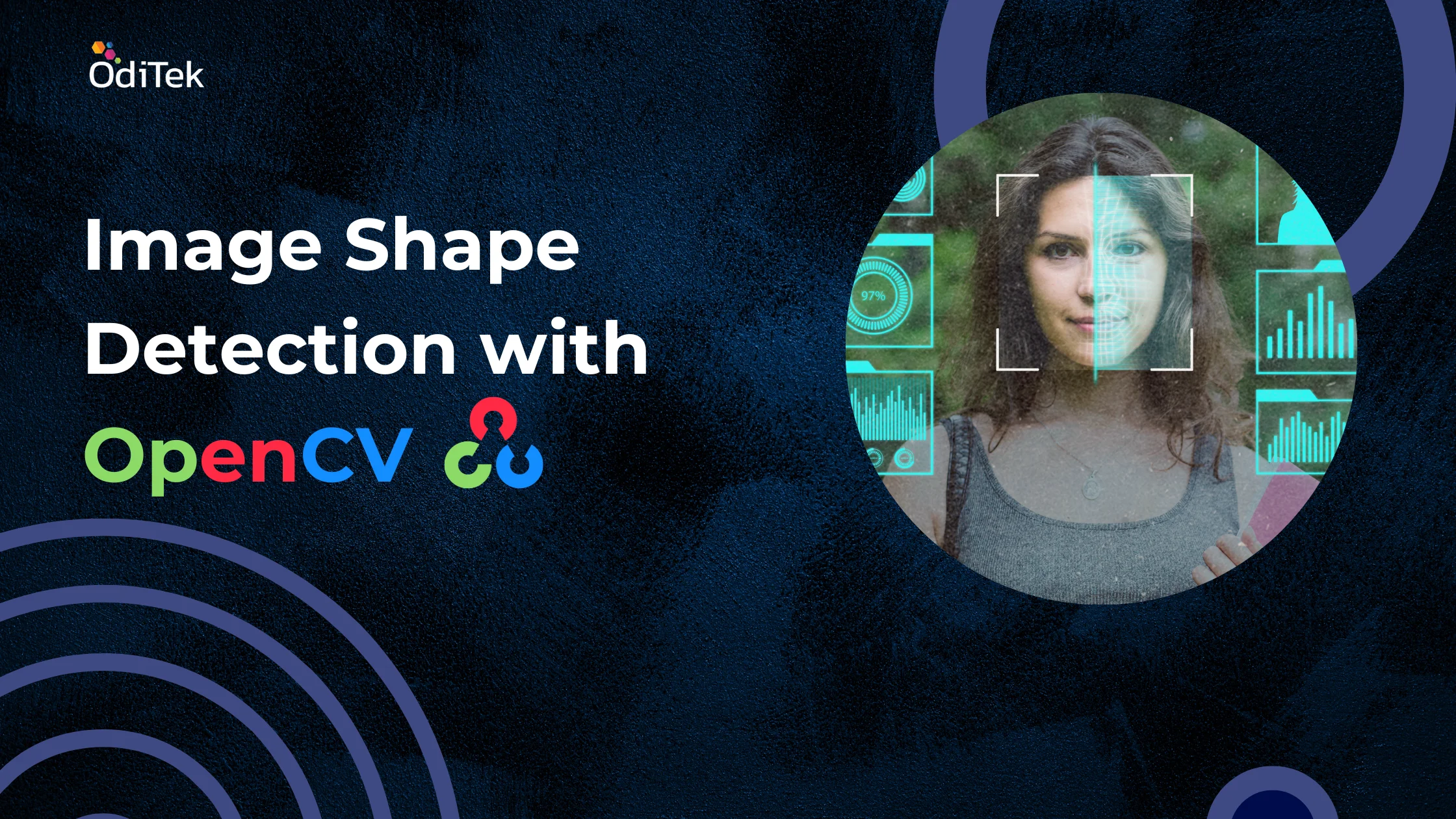OpenCV, or Open Source Computer Vision Library, stands as a cornerstone in the realm of computer vision and image processing. OpenCV has evolved into a powerful open-source toolset with a vast array of algorithms tailored for tasks ranging from basic image manipulation to complex object recognition and machine learning integration. At its core, OpenCV provides developers with the capability to read, process, and analyze digital images and videos with high efficiency and accuracy. In this comprehensive guide, we delve into the intricate art of image shape detection using OpenCV. This exploration not only elucidates the methodologies behind shape detection but also underscores the practical applications across diverse industries.
Introduction to OpenCV
As we have already explained in our previous blogs, OpenCV is an open-source computer vision and machine learning software library. It includes hundreds of computer vision algorithms that help developers perform tasks such as image processing, object detection, and image stitching. One of the essential functionalities in OpenCV is reading and manipulating images, which forms the foundation for more advanced tasks like shape detection.
Check our blog page to know more!
Reading an Image with OpenCV
Before diving into shape detection, let’s start with reading an image using OpenCV. The cv2.imread() function is the most commonly used method to read an image in OpenCV. This function allows you to load an image from a specified path, which can then be manipulated and processed for various applications. Displaying the image using OpenCV functions enables a visual verification that the image has been loaded correctly.
Image Shape Detection with OpenCV
Now that we can read an image, let’s move on to detecting shapes within it. Shape detection is crucial in various applications such as object recognition, robotics, and computer vision. OpenCV provides tools to detect shapes like circles, rectangles, and other polygons.
Steps for Shape Detection
Convert the Image to Grayscale: Converting the image to grayscale simplifies the shape detection process.
Apply Gaussian Blur: Blurring helps in reducing noise which can interfere with shape detection.
Edge Detection: Using the Canny edge detection algorithm to find the edges in the image.
Find Contours: Contours are curves that join all the continuous points along a boundary with the same color or intensity.
Approximate Contours: Simplifying the contours to detect shapes like circles, squares, or triangles.
Key Points of Shape Detection
Grayscale Conversion: By converting an image to grayscale using OpenCV read image, you remove color information and focus solely on the shape and structure of objects.
Blurring: Applying Gaussian blur reduces image noise and detail, making it easier to detect the primary edges and contours of shapes.
Edge Detection: The Canny edge detection algorithm helps in identifying the edges in an image, which are critical for detecting shapes.
Contour Finding: Contours represent the boundaries of objects within an image. Detecting these contours is essential for shape recognition.
Contour Approximation: This technique simplifies detected contours, making it easier to classify shapes based on the number of vertices or edges they have.
Practical Applications of Shape Detection
Shape detection has a wide range of applications across various industries:
Automotive Industry: Shape detection is used in autonomous vehicles for object recognition and obstacle avoidance.
Healthcare: In medical imaging, shape detection helps in identifying and analyzing different anatomical structures.
Manufacturing: Shape detection is crucial in quality control, where it helps in identifying defects and ensuring the accuracy of manufactured parts.
Surveillance: In security systems, shape detection aids in recognizing and tracking objects or individuals in video feeds.
Augmented Reality: Shape detection is used to overlay digital information onto physical objects, enhancing user interaction.
Challenges in Shape Detection
Despite its powerful capabilities, shape detection using OpenCV can present several challenges:
Noise and Distortion: Images with high levels of noise or distortion can make it difficult to accurately detect shapes.
Complex Backgrounds: Detecting shapes in images with complex or cluttered backgrounds can be challenging.
Partial Occlusion: When objects are partially obscured by other elements in the image, shape detection algorithms may struggle to accurately identify the shapes.
Variations in Lighting: Changes in lighting conditions can affect the appearance of shapes, making them harder to detect.
Tips for Effective Shape Detection
To achieve accurate and reliable shape detection results, consider the following tips:
Preprocessing:
Apply preprocessing techniques such as noise reduction and contrast enhancement to improve the quality of the input image.
Thresholding:
Use adaptive thresholding methods to handle variations in lighting and improve edge detection accuracy.
Morphological Operations:
Apply morphological operations like dilation and erosion to refine the detected shapes and remove small artifacts.
Multiple Algorithms:
Combine multiple shape detection algorithms to handle different types of shapes and improve overall accuracy.
Parameter Tuning:
Experiment with different parameter values for algorithms like Canny edge detection to achieve optimal results for your specific use case.
Integrating Shape Detection with Machine Learning
Integrating shape detection with machine learning can significantly enhance the accuracy and efficiency of image analysis. By combining the capabilities of OpenCV with machine learning algorithms, you can create powerful solutions for various applications.
Steps for Integration
Data Collection and Preprocessing:
Collect a large dataset of images containing various shapes.
Use OpenCV read image to preprocess the images, including resizing, grayscale conversion, and noise reduction.
Feature Extraction:
Utilize OpenCV’s shape detection algorithms to extract features such as edges, contours, and vertices.
Represent these features in a format suitable for machine learning models.
Model Training:
Choose a suitable machine learning algorithm, such as Support Vector Machines (SVM), Random Forest, or Neural Networks.
Train the model using the extracted features and corresponding labels (shape types).
Model Evaluation:
Evaluate the model’s performance using metrics like accuracy, precision, recall, and F1-score.
Fine-tune the model by adjusting hyperparameters and incorporating additional features if necessary.
Deployment:
Integrate the trained model with the OpenCV-based shape detection pipeline.
Deploy the solution in real-time applications, such as automated inspection systems or autonomous vehicles.
Benefits of Integration
Improved Accuracy:
Machine learning models can learn complex patterns and improve the accuracy of shape detection, especially in challenging scenarios.
Scalability:
Once trained, machine learning models can process large volumes of data efficiently, making them suitable for real-time applications.
Adaptability:
Machine learning models can be retrained with new data, allowing them to adapt to changing environments and new types of shapes.
Future Trends in Shape Detection
Shape detection is an evolving field, and several emerging trends are set to enhance its capabilities:
Deep Learning:
Deep learning techniques, such as Convolutional Neural Networks (CNNs), are being increasingly used for shape detection due to their ability to learn complex features directly from raw images.
Edge AI:
Implementing shape detection algorithms on edge devices enables real-time processing and reduces the need for high-bandwidth data transmission to centralized servers.
3D Shape Detection:
Moving beyond 2D images, 3D shape detection leverages depth sensors and 3D imaging technologies to analyze objects in three dimensions, providing more detailed and accurate shape information.
Integration with Augmented Reality (AR):
Shape detection can be integrated with AR applications to provide interactive and immersive experiences by recognizing and overlaying digital information on physical objects.
Explainable AI:
As AI and machine learning models become more complex, there is a growing need for explainable AI techniques to make the shape detection process transparent and understandable to users.
How OdiTek Can Help
At OdiTek, we stay at the forefront of technological advancements in computer vision and machine learning. Our team is well-versed in integrating shape detection with advanced machine learning techniques, ensuring your solutions are not only effective but also future-proof. Here’s how we can support you:
AI and Machine Learning Expertise:
We leverage the latest AI and machine learning algorithms to enhance shape detection accuracy and performance.
Real-Time Processing:
Our solutions are optimized for real-time processing on edge devices, ensuring immediate results for time-sensitive applications.
3D Vision Solutions:
We develop advanced 3D shape detection systems for applications requiring detailed spatial analysis.
Customized AR Integration:
Our team can integrate shape detection with AR applications, providing interactive and engaging user experiences.
Transparent AI Solutions:
We focus on developing explainable AI models, ensuring that the shape detection process is understandable and trustworthy.
Conclusion
Shape detection is a vital aspect of computer vision, and OpenCV provides powerful tools to achieve this. By leveraging OpenCV’s capabilities, you can develop sophisticated applications that can detect and analyze shapes effectively. With OdiTek’s expertise in OpenCV development, you can be assured of high-quality solutions tailored to your needs.
If you have any projects requiring advanced computer vision capabilities or need expert assistance with OpenCV, don’t hesitate to reach out to OdiTek. Let’s connect and explore how we can collaborate to bring your vision to life.







